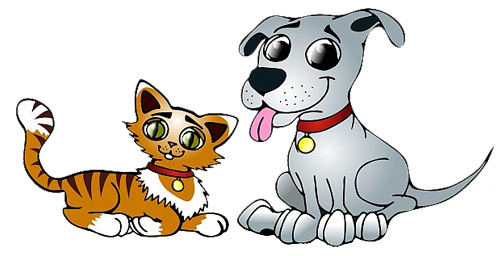There are vegetables dogs can eat and love to nibble on but not so much for cats. Dogs can eat around 30% plant foods in their daily diet. Cats only require around 5-10%.
Vegetables in your dog’s diet, and minor amounts in your cat’s diet, can enhance their health and provide a rich and diverse supply of nutrients, enzymes, healthy fiber and antioxidants.
 Canines possess a greater ability to break down plant matter and make use of the relevant nutrients. So, even though dogs are mostly carnivorous, like cats, they are in fact omnivorous, not solely reliant on animal protein for sustenance.
Canines possess a greater ability to break down plant matter and make use of the relevant nutrients. So, even though dogs are mostly carnivorous, like cats, they are in fact omnivorous, not solely reliant on animal protein for sustenance.
Cats, on the other hand, are carnivores and are, in fact, unable to manufacture essential nutrients from plant matter. Unlike omnivores, cats also cannot convert vitamin A from beta-carotene in plants and need animal-derived sources of vitamin A, such as liver.
Cats require a lot more protein in their diet than dogs and are in no way adapted to digesting carbohydrates. Cats can rely pretty much entirely on protein and fat for energy conversion.
The problem with commercial pet foods…
It’s a very good thing that pet owners are moving away from toxic, poor grade commercial pet foods. Natural, holistic, homemade (and even raw diets) are being favored, which can include healthy plant-based ingredients. However, not grains! They are used as cheap fillers in commercial products, even though they are not good for cats or dogs.
Dogs can eat around 30% plant foods in their daily diet. Cats only require around 5-10%. With both, ensure vegetables are well-blended because they do not easily digest cellulose. This also makes it easy to mix the vegetables with the rest of the homemade meal.
TIP: Since cats only require a very small amount of vegetables in their meal, blend them and freeze the mix in an ice-cube tray and then defrost one cube a day for their meals.
Including Vegetables Dogs Can Eat…
A range of vegetables is best and always aim to include something green. Green vegetables contain cleansing and detoxifying chlorophyll. It is a great liver ally and shows anti-carcinogenic potential.
You can use throw away vegetable parts such as outer leaves, ends and stems or left over cooked vegetables that you don’t consume. Raw is always preferable because nutrient and enzyme content is at a maximum.
Specific Vegetables Dogs Can Eat…
You can experiment with most vegetables. Vegetables dogs can eat include: carrots, celery, chard, spinach, kale, squash, watercress, cabbage, turnips, broccoli, peas, green beans, cauliflower and asparagus.
Some below-ground vegetables such as carrots and sweet potatoes are also included in the list of vegetables dogs can eat. These are higher in sugar content however and as such should be used in smaller proportion to any above-ground vegetable choices. You can add some occasional fruit also such as blueberries, bananas, apples, papaya or pear.
Beware: Vegetables Dogs (or Cats) Cannot Eat!
As a note, raw onions are not friendly on your pet’s digestive system and can be dangerous to their health so should be avoided. Garlic is also a health risk for cats, though minor amounts occasionally in your dog’s diet may serve as a natural flea repellent, be sparing however as the sulphides in garlic can be detrimental to the blood cells of animals. Also avoid tomatoes, peppers, corn, cucumber and potato.
If you would like to change your pet’s diet to a healthy, holistic, species-appropriate diet or are embarking on a natural homemade or raw food diet research the area first as nutritional balance is essential.
So, now that you know there are indeed vegetables dogs can eat (and a little for cats), see which ones your pet enjoys!
By the way, here’s another source for information about vegetables dogs can eat >>
[xyz-ihs snippet=”Signoff1″]
